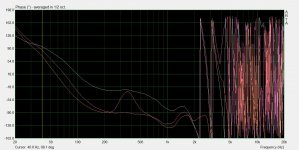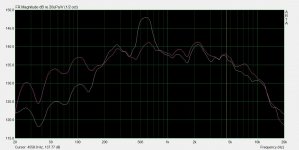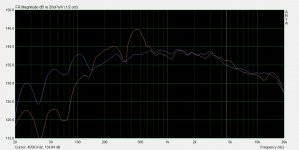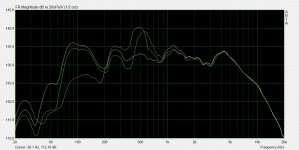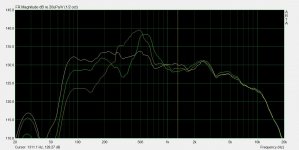I did some more testing and measuring yesterday.
First I was looking at the phase of the 'system'. I fed a 10" sub with another amp, and measured the signal coming from the class D amp I used to drive the sub normally. You could say, I broke the loop at the speaker terminals.
This graph is with 100Hz LP, 10Hz LP and added weight to the speaker cone. I used a pretty heavy weight, a ball race from a big ball bearing I found in the garage that I stuch to the cone, 50g or more.
The weight caused a 'hump' around 350Hz, not sure why. But the phase at LF got better with each change.
I will post more measurements later.
First I was looking at the phase of the 'system'. I fed a 10" sub with another amp, and measured the signal coming from the class D amp I used to drive the sub normally. You could say, I broke the loop at the speaker terminals.
This graph is with 100Hz LP, 10Hz LP and added weight to the speaker cone. I used a pretty heavy weight, a ball race from a big ball bearing I found in the garage that I stuch to the cone, 50g or more.
The weight caused a 'hump' around 350Hz, not sure why. But the phase at LF got better with each change.
I will post more measurements later.
Attachments
Now think it through. What is needed to induce an eigentone? A point source radiating that specific frequency, right? Now what happens when you add a second point source, radiating that same frequency, at a different location in the enclosed space? The resonance is out of phase with one of the sources. Therefore, with spatial distribution of sources you have active cancellation of eigentones. Without feedback solutions that mess up easily. If and only if the placement and phase alignment of the sources is correct of course. But that's why everyone wants multisub systems.
I have tried subs, but was never happy with the results. I had up to three subs at different locations, played with MSO, REW, EQ APO, RePhase etc, active XO speakers, but was never happy with the bass. And the complexity gets tiring. I ended up throwing everything out and went back to plain stereo speakers with passive XO. I saw this concept and thought it might be a simple solution to my 40Hz problem. If that could be fixed, I think I would be pretty pleased.
Here are some tests with the sealed 10" sub and weighted cone.
First with mic in front of the woofer, and second with the mic a little bit to the side at the edge of the woofer, and angled away. I could turn up the gain more with this position.
Not optimal placement or anything, just free standing and with the measurement mic next to the 'feedback mic'. Just to see where it's canceling or boosting.
One reference curve, and one with the system connected.
This one looks promising for LF, but the 'boosting' at higher frequencies is a bit annoying. This is the same in all cases..
First with mic in front of the woofer, and second with the mic a little bit to the side at the edge of the woofer, and angled away. I could turn up the gain more with this position.
Not optimal placement or anything, just free standing and with the measurement mic next to the 'feedback mic'. Just to see where it's canceling or boosting.
One reference curve, and one with the system connected.
This one looks promising for LF, but the 'boosting' at higher frequencies is a bit annoying. This is the same in all cases..
Attachments
Last edited:
Here I tried a cheap 8" in a sealed box. Mic to the side of the woofer. Disconnected, active, and with added weight to the cone(green). It really 'dies' with the added weight. Not sure why, but maybe because the woofer has a weak motor. Not so good..
Attachments
Here is a Peerless 8" poly 'hifi woofer'. Baseline, std and added weight. Mic at the side of the woofer.
Added weight helps a bit in the LF, but kills it higher up. Weight is probably too heavy for the weak motors, but works better on the sub with a heavy cone and strong motor.
Added weight helps a bit in the LF, but kills it higher up. Weight is probably too heavy for the weak motors, but works better on the sub with a heavy cone and strong motor.
Attachments
Last edited:
I did some listening test with the sub, so I placed it next to the back wall in the garage, and turned on some music. I could not hear a big difference when i turned it on and off with music, and there was some sporadic oscillations around a few Hz. However, the garage stereo is not going very low.
However, when I happened to hit the wall behind it, I saw the cone moving a lot, so I tried turning it off. There was a major LF resonance (maybe 30Hz) from banging the wall, and it was ringing a long time, but with the system active, the ringing was gone. Silence. Big difference!
However, when I happened to hit the wall behind it, I saw the cone moving a lot, so I tried turning it off. There was a major LF resonance (maybe 30Hz) from banging the wall, and it was ringing a long time, but with the system active, the ringing was gone. Silence. Big difference!
Why are you adding weight to the cones when using an active system?
And this wall, it seems to me it has some construction issues. This to my knowledge only happens with relative stiff and light yet unsupported materials like metal garage doors. Bringing the resonance down by adding weight to the wall might cure this.
And this wall, it seems to me it has some construction issues. This to my knowledge only happens with relative stiff and light yet unsupported materials like metal garage doors. Bringing the resonance down by adding weight to the wall might cure this.
Adding weight seemed to improve LF phase in the feedback loop since it's moving the woofer resonance lower. You can see that in the graphs too, adding the weight improves the cancellation at low frequencies. But it also has a lot of negative effects higher up in frequency.
The wall I will not comment, I don't build houses. It was just an observation about sound cancellation.
The wall I will not comment, I don't build houses. It was just an observation about sound cancellation.
I would do an attenuation of the feedback at higher frequencies so that I could increase gain, and have more feedback at low frequencies without the weight... seems impractical.
Actually you can do one of my tricks, take a razor blade and cut away "tårtbitar" slices of the spider. That decreases fs without adding mass...
Actually you can do one of my tricks, take a razor blade and cut away "tårtbitar" slices of the spider. That decreases fs without adding mass...
Now think it through....
Yes, that is helpfui; I see what you mean.
But what I meant, even if not quite right, is related to the other matter I've been pondering: Toole's critique of room EQ.
Toole distinguishes fixing the room and fixing the speakers. In his context, there is no need to EQ a room since your brain adjusts for the room's tone colouration. Uncle Harry sounds like himself in all rooms.
So in that sense, active damping really does change the room some but moving the speakers around does not.
It is true to say that the location of multiple Geddes-like subs mixes-and-matches their mutual phase relationships. And locating the speakers properly does affect how the eigentones are stimulated. Sure.
But those relationships change as the frequency changes and not in any way leading to reasoned design choices. But perhaps you could make a choice to address only one frequency and let all the other eigentones sort-out as they will.
B.
@ ESL 63
So you mean I should have another LP filter set at maybe 100Hz? As it is now, I have a first order LP at abt 10Hz on the mic. Adding another 'pole' at 100Hz would increase phase rotation, and possibly make feedback worse, meaning I would have to decrease the gain. Well, maybe I should try it..
I'm not sure I want to cut the spiders.. I can remove the weight, but not the cuts.. It might actually work without the weight too, since I added capacitance in the mic-amp. I think that was the main bottleneck in my first attempt. I think the weight can be optimized too, this was just a quick test.
Cutting the spider I think also is a matter of the relation between the stiffness of the 'air spring' (the box) and the spider 'spring stiffness'. If the spider is relatively soft, and the sealed box is small, cutting the spider will not do much. The 10" sub is in a sealed 30L box (from memory) and Vas is 37, so it might actually help cutting..
So you mean I should have another LP filter set at maybe 100Hz? As it is now, I have a first order LP at abt 10Hz on the mic. Adding another 'pole' at 100Hz would increase phase rotation, and possibly make feedback worse, meaning I would have to decrease the gain. Well, maybe I should try it..
I'm not sure I want to cut the spiders.. I can remove the weight, but not the cuts.. It might actually work without the weight too, since I added capacitance in the mic-amp. I think that was the main bottleneck in my first attempt. I think the weight can be optimized too, this was just a quick test.
Cutting the spider I think also is a matter of the relation between the stiffness of the 'air spring' (the box) and the spider 'spring stiffness'. If the spider is relatively soft, and the sealed box is small, cutting the spider will not do much. The 10" sub is in a sealed 30L box (from memory) and Vas is 37, so it might actually help cutting..
Last edited:
Changing the parameters of a certain driver in a certain closed box can simply be arranged for by using the well known LT filter. Cheaper than ruining a driver imho. I've not dug deep enough in the feedback arrangement and the phase requirements, but even a bandpass filter with fc at 40Hz in the electric part of the loop could work out, I presume.
So, I have brought the 'canceler' home and tried it in the only position I can place it (back right corner), and I can't measure any difference in the listening position (40Hz amplitude or decay), and can't hear a definite improvement. Possibly placebo if I hear something. It is working hard when doors are opened and closed though 
Not sure if I should continue this. To be able to place them in other positions they need to be smaller, like 6.5" in a tube could work physically, but not sure I can get 40Hz performance with that, with drivers I have lying around at least. I don't want to spend big bucks either on something that might or might not work.
Not sure if I should continue this. To be able to place them in other positions they need to be smaller, like 6.5" in a tube could work physically, but not sure I can get 40Hz performance with that, with drivers I have lying around at least. I don't want to spend big bucks either on something that might or might not work.
Ok, looking a little bit more at the graphs in REW, I can see it does improve stuff in the 100Hz range, so maybe that's what I can hear. In the 40Hz I was concentrating on , it remains basically the same. I also see more ringing in the 10Hz area when it is active, so I guess it's adding and not canceling down there.
I'm back 
I moved to another apartment, and this one is a 'concrete cave' with really bad acoustics. I have some modes at 30 and 60 Hz, and also a lot of higher resonances because of the highly reflective walls.
I got a bit desperate, so I thought I would re-visit this. I dragged one of the sturdy sealed 10" subs home, placed it in the rear left corner, and connected it the same way as before. It did help in the 30Hz area, and also added around 15Hz, but also some addition above 100Hz.
I did not hear much difference when listening. I then moved it in the FL corner behind the left speaker, and things sounded better.
I then disconnected the input filter (RC) and tried again, and it was even better, improving a lot of the nodes at higher frequencies. The room sounded a lot cleaner, and measured better.
They still add reverb in the 15Hz area, but by listening I can't really detect any problem with that.
I'm thinking of building some more and placing them around the room. I also have windows behind the listening position, so I'm thinking I could try one in that position.
The sub I'm using now is big and heavy, I'm thinking I would try to build something from 'paper tubes' with some smaller drivers I have left over. Maybe they won't do much at LF, but could clean up the higher bass.
For sure I have to make some kind of absorbers too, but if I could clean up the bass with these, I could keep the passive absorbers smaller in size. I'm desperate for this to work, because reading about fixing bass with passive traps, I understand it will be complicated, expensive and take a lot of space..
As a side-note from my previous apartment, I later built some wide baffle speakers (Troels PMS type), and was able to somewhat tune them 'with the room', and the end result was pretty good.
I moved to another apartment, and this one is a 'concrete cave' with really bad acoustics. I have some modes at 30 and 60 Hz, and also a lot of higher resonances because of the highly reflective walls.
I got a bit desperate, so I thought I would re-visit this. I dragged one of the sturdy sealed 10" subs home, placed it in the rear left corner, and connected it the same way as before. It did help in the 30Hz area, and also added around 15Hz, but also some addition above 100Hz.
I did not hear much difference when listening. I then moved it in the FL corner behind the left speaker, and things sounded better.
I then disconnected the input filter (RC) and tried again, and it was even better, improving a lot of the nodes at higher frequencies. The room sounded a lot cleaner, and measured better.
They still add reverb in the 15Hz area, but by listening I can't really detect any problem with that.
I'm thinking of building some more and placing them around the room. I also have windows behind the listening position, so I'm thinking I could try one in that position.
The sub I'm using now is big and heavy, I'm thinking I would try to build something from 'paper tubes' with some smaller drivers I have left over. Maybe they won't do much at LF, but could clean up the higher bass.
For sure I have to make some kind of absorbers too, but if I could clean up the bass with these, I could keep the passive absorbers smaller in size. I'm desperate for this to work, because reading about fixing bass with passive traps, I understand it will be complicated, expensive and take a lot of space..
As a side-note from my previous apartment, I later built some wide baffle speakers (Troels PMS type), and was able to somewhat tune them 'with the room', and the end result was pretty good.
Last edited:
Where you sit matters a whole lot in that concrete cave. Being too central very bad.
My music room has some large clothes closets - big difference if I slide open the door to one of them in particular (and it's the one holding my heavy winter motorcycle clothing). My point is that you may have furnishings that help a lot - any put anywhere will help some.
Hanging heavy carpets on the walls off thick battens could help.
95% of the room photos shown in this forum look hideously reverberant to me.
My music room has some large clothes closets - big difference if I slide open the door to one of them in particular (and it's the one holding my heavy winter motorcycle clothing). My point is that you may have furnishings that help a lot - any put anywhere will help some.
Hanging heavy carpets on the walls off thick battens could help.
95% of the room photos shown in this forum look hideously reverberant to me.
Place the construction inside a tube trap or behind fiber glass to achieve best performance
Hello esl63, Not sure placing behind fibre Glass makes a différence. Ok, its a low pass acoustic filtre. I experienced this a lot and I came to thé conclusion cône break UP wad thé limiting factor for instability. Did you gain substancial improvements by using fiber Glass?
Inside a tube trap ? Do you mean a sealed tube connected to thé rear side of speaker liké in thé Pass patent?
You are correct, by adding the glass fibre outside the active absorber the low pass filter makes the hf distortion noice less audible and the bennefit I found is that you can increase the feedback a little extra without instability. You get slightly higher phase margin, and by that greater reduction.
Thanks for your quick answer. Will try that. Already damped thé cône with pva glue, will try to get a bit further with rockwool. Will try also to add also velocity feedback to be a bit more broadband. Did you triéd accélération feedback ? Same effect as adding mass...
Also, you mentionned a groupe buy in the swedish forum, coforum, could you post a direct link? A bit hard to me tonfind it
Also, you mentionned a groupe buy in the swedish forum, coforum, could you post a direct link? A bit hard to me tonfind it
- Home
- General Interest
- Room Acoustics & Mods
- Active room damping
